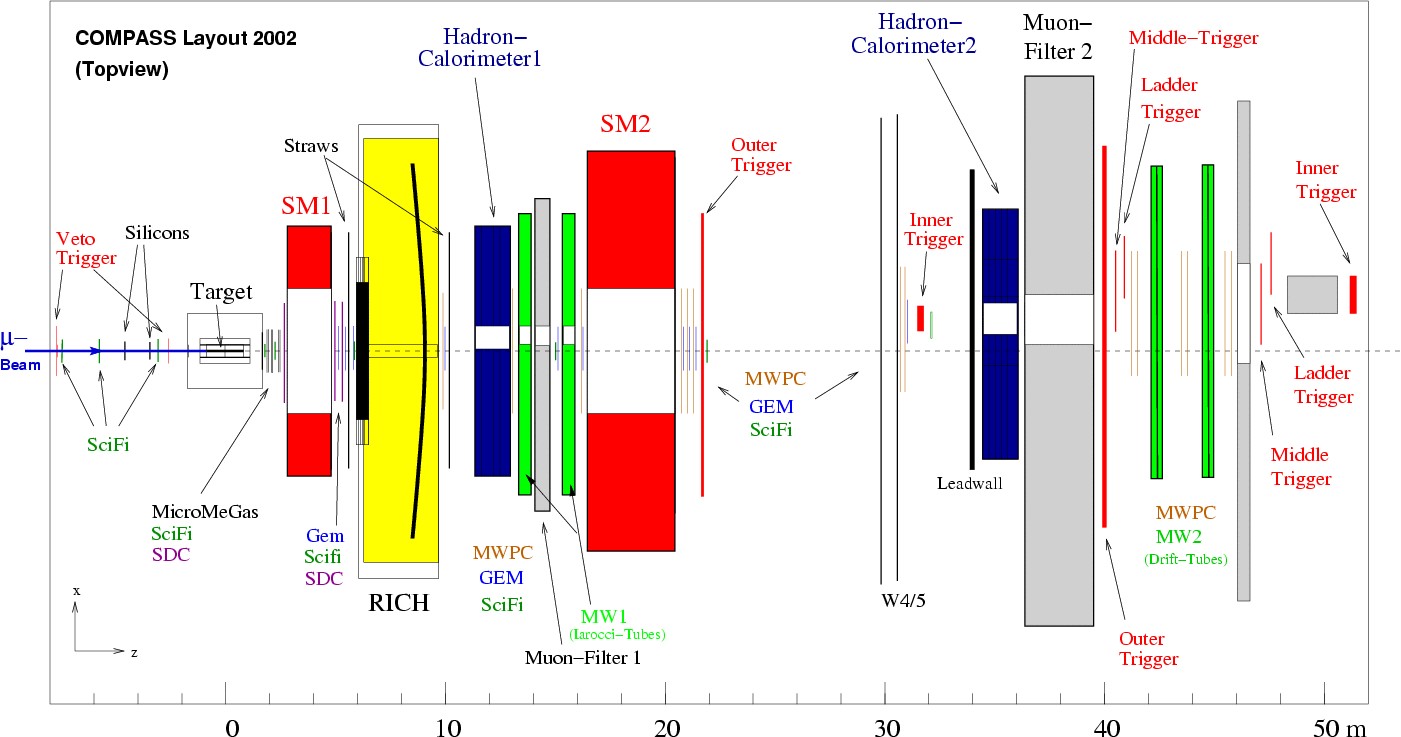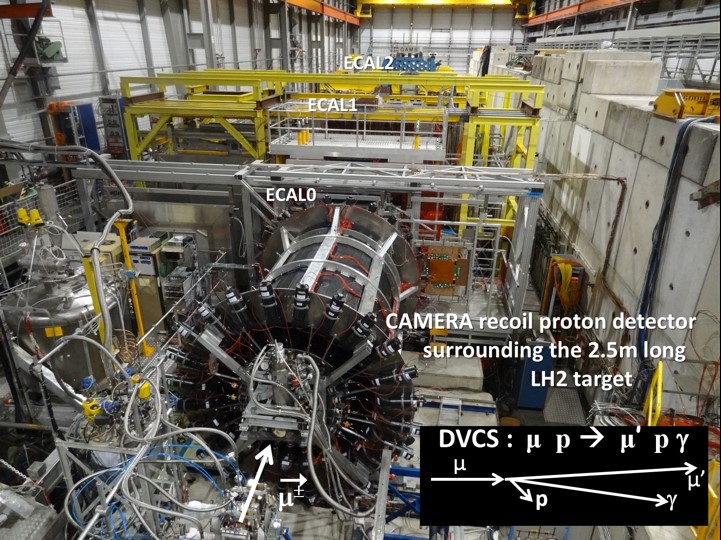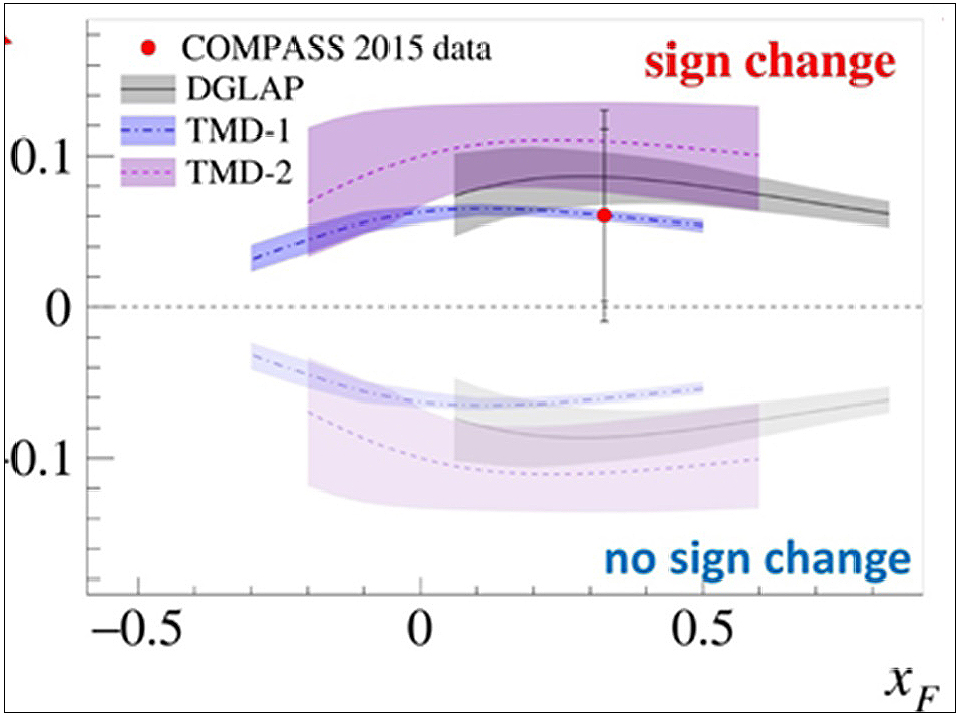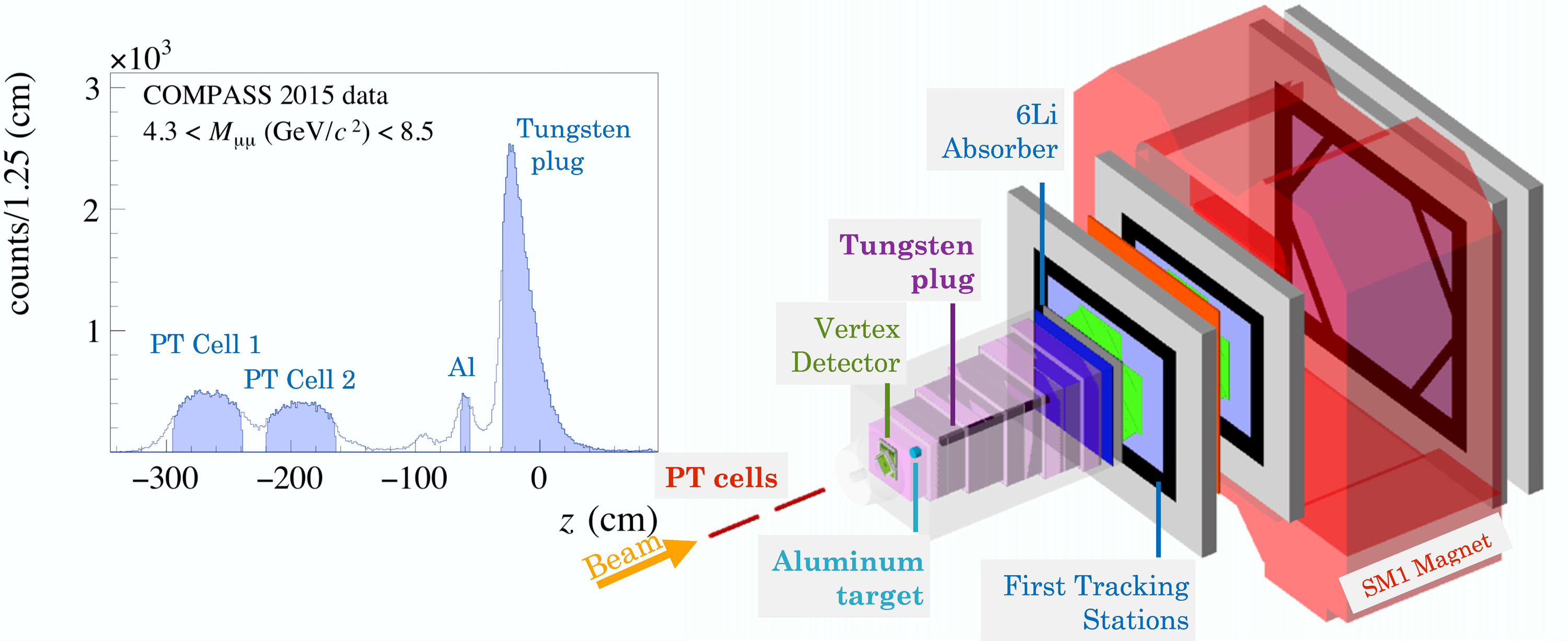COMPASS and COMPASS-II. Twenty Years of Successful Measurements
Publications, 22 July 2020
COMPASS-II is currently one of the leading experiments in high-energy spin physics and hadron spectroscopy, running on the Super Proton Synchrotron (SPS) at CERN in Geneva, Switzerland. The experiment and collaboration have a fairly long history, the experiment was approved by CERN in February 1997, and a final Memorandum of understanding was signed in September 1998, including with JINR [1‒2].
The spectrometer (Fig. 1) was installed in 1999‒2000 and put into operation during the technical run in 2001. In the summer of 2002, the first set of experimental data with a muon beam and polarized targets started [3].
 Fig. 1. Experimental set-up of COMPASS in 2002
Fig. 1. Experimental set-up of COMPASS in 2002
The physical measurement programme performed in 2002‒2018 is shown in the table.
Measurement Programme of COMPASS and COMPASS-II
|
Year |
Beam |
Target |
Measurement |
|
2002 |
µ-, 160 GeV/c |
6LiD |
SIDIS |
|
2003 |
µ-, 160 GeV/c |
6LiD |
SIDIS |
|
2004 |
µ-, 160 GeV/c /c |
6LiD |
SIDIS |
|
2006 |
µ-, 160 GeV/c |
6LiD |
SIDIS |
|
2007 |
µ-, 160 GeV/c GeV/c |
NH3 |
SIDIS |
|
2008 |
π-, 190 GeV/c |
LH2 |
Hadron spectroscopy |
|
2009 |
π-, 190 GeV/c |
LH2, Ni, W, Pb |
Hadron spectroscopy, Primakoff |
|
2010 |
µ-, 160 GeV/c |
NH3 |
SIDIS |
|
2011 |
µ-, 160 GeV/c /c |
NH3 |
SIDIS |
|
2012 |
µ-, 160 GeV/c (test) π-, 190 GeV/c |
LH2 Ni, C, W, Pb |
DVCS Hadron spectroscopy, Primakoff |
|
2014 |
π-, 190 GeV/c (test) |
NH3 |
Drell‒Yan |
|
2015 |
π-, 190 GeV/c |
NH3 |
Drell‒Yan |
|
2016 |
µ-, 160 GeV/c |
LH2 |
DVCS |
|
2017 |
µ-, 160 GeV/c |
LH2 |
DVCS |
|
2018 |
π-, 190 GeV/c |
NH3 |
Drell‒Yan |
The COMPASS-II experimental programme, approved in 2010, is mainly devoted to the study of the transverse and three-dimensional structure of nucleons and Drell‒Jan (DY) reactions [4]. This measurement programme started in 2012 with a data taking for Primakov reactions and a preliminary (test) data taking for studies of deep inelastic virtual scattering on a muon beam with an energy of 160 GeV and a long liquid hydrogen target. For these studies, two new detectors were created: the recoil detector and the electromagnetic calorimeter, which was built mainly by the JINR group [5] (Fig. 2).
 Fig. 2. The forward part of the COMPASS-II set-up for measuring deep inelastic virtual scattering of leptons on nuclei
Fig. 2. The forward part of the COMPASS-II set-up for measuring deep inelastic virtual scattering of leptons on nuclei
The physical programme and the results of the COMPASS and COMPASS-II experiments are a unique example of combining very different studies ― from Primakoff reactions to gluon polarization. Such a wide range of tasks required new methods for preparing of detectors and targets.
Of particular note are pioneering measurements that have never been performed before in other experiments ― the study of transverse spin distributions in Drell‒Yan processes on a beam of negative pions and with a polarized proton target. These measurements were successfully completed in 2015 and continued in 2018.
Already the first results of studies of the Drell‒Yan processes have shown that such measurements are an important component of the study of the structure of nucleons. The fact is that the parton distributions that are measured in these processes are not evaluated with fragmentation functions, as is the case in semi-inclusive reactions. Thus, it is not necessary to use data from other experiments to obtain results, which significantly improves the systematic uncertainty in the results obtained. Another important feature of research on the structure of nucleons on the COMPASS and COMPASS-II set-up is the possibility to perform measurements of Drell‒Yan processes and semi-inclusive processes on the same set of detectors, which again minimizes the systematic uncertainties of the results of parton distributions measured in these processes.
Already the first results of measurements showed great opportunities for installing COMPASS-II to study the Drell‒Yan processes [6]. It was found that the observed Sivers asymmetry sign is consistent with the fundamental QCD prediction that the Sivers asymmetry extracted from the data on the Drell‒Yan processes has a sign opposite to the sign extracted from the data on the semi-inclusive deep-inelastic scattering (Fig. 3).
 Fig. 3. Sivers asymmetry measured in the Drell‒Yan processes and theoretical predictions based on sign changes (see explanations in the text)
Fig. 3. Sivers asymmetry measured in the Drell‒Yan processes and theoretical predictions based on sign changes (see explanations in the text)
The data taking of experimental statistics was continued in 2018. The first results of this data will be presented in the near future.
It is important to note that the analysis of non-polarized experimental data of the Drell‒Jan processes is also active. These studies have four main goals:
- study of distributions of valence quarks in a pion;
- getting data on the of Boer-Mulders parton distribution;
- check the Lam‒Tung ratio;
- study of the dependence of cross-section relations on nuclei of different types (EMC effect and Cronin effect).
The last point of research is possible due to the use of a complex absorber to absorb the hadron background in measurements on the COMPASS-II installation (Fig. 4) [6].
 Fig. 4. Compass-II absorber for measuring Drell‒Yan processes and event distribution in the absorber elements
Fig. 4. Compass-II absorber for measuring Drell‒Yan processes and event distribution in the absorber elements
This allows one to get data not only on the hydrogen core, but also on the aluminum and tungsten cores. In the processing of experimental material for these nuclei, DLNP physicists are actively involved.
It is important to note that the first theoretical foundations for measuring Drell‒Yan processes were developed by JINR physicists in [7]. The development of the theory on this topic laid the foundations for successful experimental measurements of these processes in the COMPASS-II experiment [4‒6].
The radiation of polarized Drell‒Yan processes remains an important point in the scientific programmes of many high-energy physics experiments, including the SPD experiment on the NICA collider [8].
References
- COMPASS Collab. Proposal. CERN/SPSLC 96-14, SPSLC/P297, 1 March 1996.
- COMPASS. MoU, 2 September 1998. http://wwwcompass.cern.ch/compass/gl/documents/mou/MOUFIN_D.pdf
- COMPASS Collab. // NIM A. 2007. V. 577. P. 455–518.
- COMPASS Collab. COMPASS-II Proposal. SPSC-2010-014/P-340, 17 May 2010. http://wwwcompass.cern.ch/compass/proposal/compass-II_proposal/compass-II_proposal.pdf
- Krumsteyn Z. V., Nagaytsev А. P., Оlchevsky А. G., Savin I. А. New Electro-Magnetic Calorimeter for COMPASS at CERN. /posts/new-electromagnetic-calorimeter-for-the-compass-experiment-at-cern/.
- COMPASS Collab. // PRL. 2017. V. 119. P. 112002.
- Маtveev В., Мuradyan Р., Таvkhelidze А. Production of Muon Pairs in Strong Interactions and Asymptotic Sum Rules. JINR Preprint R2-4543. Dubna, 1969; Preprint SLAC_TRANS_0098.
- Tsenov R. et al. Conceptual and Technical Design of the Spin Physics Detector (SPD) at the NICA Collider. JINR PAC, Jan 2019, https://indico.jinr.ru/event/718/.
A. P. Nagaytsev, Head of the Sector of VBLHEP JINR